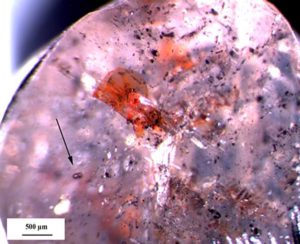
Nitrogen is one of the most enigmatic elements within system Earth. No matter where in the world scientists take measurements, in the atmosphere or in solid rock, everywhere they come across the “missing nitrogen“ problem: compared to other planets there is obviously far too little nitrogen found. The scientists Felix Kaminsky, KM Diamond Exploration, Canada, and Richard Wirth, GFZ section Chemistry and Physics of Earth Materials, now identified a “witness“ from the deep that is able to unravel the mystery.
With an amount of 78 percent nitrogen is the main component of air on Earth and it also is a key component of life. A comparison with other planets, however, reveals that there should be a much higher amount found on Earth. According to recent estimates the balance is missing up to 90 percent of nitrogen. Where is it gone? Existing hypotheses assume that large amounts of nitrogen may have been degassed during the formation of Earth or following a meteor impact. Another hypothesis assumes that large amounts of nitrogen may be found within the Earth’s interior, in the Earth’s mantle or core. Since measuring devices cannot reach down there these are, however, not more than assumptions so far.
Diamonds from Northwest Brazil now give the crucial hint. In Rio Soriso volcanic vents, called kimberlite pipes, broke through the Earth’s crust and thereby transported the diamonds up to the Earth’s surface. Felix Kaminsky and Richard Wirth now precisely investigated the molecular composition of inclusions within the diamonds and published their results in the scientific journal American Mineralogist. Wirth: “Diamonds are formed under high pressure and high temperatures within the Earth’s mantle and are transported to the Earth’s surface by volcanic activity. The chemical composition of diamonds and of the inclusions within them are therefore a reflection of the composition of the Earth’s interior”.
Diamonds from kimberlite pipes also occur on other places of the Earth, for example in South Africa, Siberia or the Canadian Shield. However, the diamonds of Rio Soriso are especially rich in inclusions. They were formed in the lowermost layers of the lower mantle and thereby allow for a rare insight into the deep. At the GFZ, Wirth investigated the inclusions by different electron-microscopic methods.
Wirth: “Unlike other diamond deposits on Earth, the inclusions of the Rio Soriso diamonds contain large amounts of nitrogen. For the first time, we were able to detect iron nitrides and carbonitride, chemical compounds of iron and carbon with nitrogen, within diamond inclusions. .” This provides science with an unambiguous proof of the existence of nitrogen in the lower Earth’s mantle and core. The scientists assume that the chemical compounds of iron nitrides and carbonitride are typical compounds of the core-mantle-boundary. Wirth: “The compounds were probably transported by liquid metal from the core to the lowermost layers of the lower mantle.” The search for the “missing nitrogen” of system Earth seems to have come to an end. (ak)
Reference:
Kaminsky, F., Wirth, R., 2017. Nitrides and carbonitrides from the lowermost mantle and their importance in the search for Earth’s “lost” nitrogen. American Mineralogist 102, 1667-1676. DOI: 10.2138/am-2017-6101
Note: The above post is reprinted from materials provided by GFZ German Research Centre for Geosciences.










